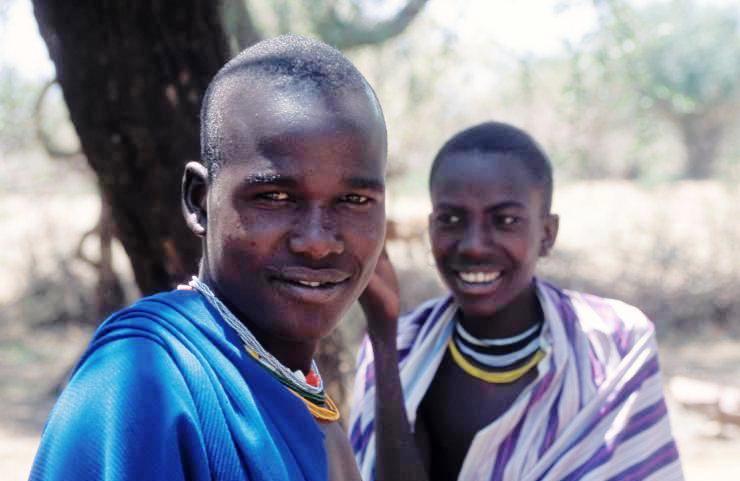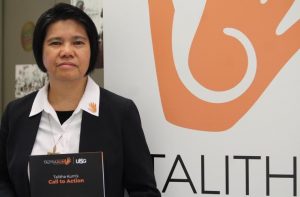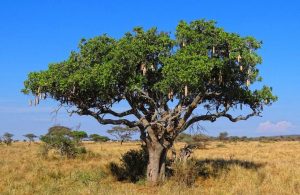Sapana’ is a rite of passage for young men. It is a recognition of their status as adult men.
Early in the morning, before the sun comes on the horizon, people assemble around the kraal. All the cattle are inside, including the bulls to be killed. Once the sun rays throw light on the mountains, people know the time has arrived for the young men to prove their prowess.
The first of the young men to kill a bull goes into the kraal brandishing his spear. As soon as he can, he pierces the bull on its right side. When the animal falls it must be pierced again, because it is not good to kill the animals with only one stab. It is a way to honour the animal, which does not die on the first attack.
Once the first bull has been killed, the next young man in line kills his own. After that, some adults slaughter the animals. While the animals are being slaughtered people can come and eat some clots of blood; however, most of the blood is kept in containers to mix it with milk later on.
All the parts of the animals are cut up: stomach, ribs, skin, head and bowels. The head and bowels are eaten by women and small children. The rest of the meat is taken by the men who had participated in the sapana, the ‘kasapanak, to the banquet area, ‘kirket‘.
Once all the meat in on the ‘kirket‘, the new ‘kasapanak‘ goes back to the kraal to bring the stomachs. Each one of them carries that of his bull.
They enter the ‘kirket and go to lay the stomachs close to where the containers of blood have been laid. Each one of the ‘kasapanak‘ stands behind the stomach he has brought. The leading one stands on the right side of the others.
The stomachs are cut open and all the cud inside is exposed. Then the main leader of the ceremony, most probably the eldest of the old men, comes and tells them to remove their shoes and to stand on top of the cud contained in the stomachs. Then he takes the contents of the stomach and smears the young man who killed the bull first with it. He smears the whole body, from the head to the toes.
When he concludes the blessing, he removes from the necks of the ‘kasapanak‘ the round of beads that each one of them has on. The beads are a token of thanks for the blessings he has given them. Then they come out from the stomachs and put on their shoes.
Then the elders cut the stomachs of the cows to give them to the ‘kasapanak‘, who will take them to the women back at home, the ‘kaa sapana’. The stomach will be stored till the last feast of this rite. Each bull’s stomach is cut into seven sections. The elders put the stomach on the chest and shoulders of the young men as though they were wearing a vest. Once at the compound of that house, the women receive the stomachs from the young men, and bless them anointing all their bodies with plenty of oil from their horns, ‘laloy‘. The women are very happy and keep on jumping, singing and yelling around the heads of the bull, and around the young men. They carry their oil horns and twigs of ‘sitöt‘.
The ‘kasapanak‘ go back to the ‘kirket‘ for a rest with their companions. At this junction, they can remove the dry grass which has remained after the smearing with cud off their bodies, a difficult task to accomplish in any case because the oil smeared by the women has glued the grass to their bodies. Each of the ‘kasapanak‘ has an old man who stands for him during this rite; he is like his godfather. Now, this old man comes close to his sponsored young man and gives him a seat, ‘ngachar’, which he will use to sit on during meetings with the ‘kokwö‘, or anywhere he goes.
In the afternoon, the new ‘kasapanak‘ are called to go to the home to bring the milk. This is not any ordinary milk; it is sour milk that many homes in the neighbourhood have been preparing during the last month for this happy occasion. Each ‘kasapanakyan‘ carries their gourd in their arms. They enter the ‘kirket‘ through the left, and take all the gourds of milk to where the basins of blood have been all this time. They kneel and one of the elders blesses the milk.
Then one of the elders stands in the middle of the circle and blesses the milk again. He pours all the milk into a different basin and mixes the milk with the blood of the bulls killed in the morning. At this moment the ‘kasapanak’ are called to come close to the milk and to kneel. The old man drinks a bit of that milk and blood and sprinkles it on the young men in the fashion of blessings. The old man kneels and shows them how to drink that blood: He leans on his right arm, drinks a bit and spits under the armpits of his two arms, under his legs, and finally on the ground and towards heaven. Then he drinks. The young men follow him and do the same.
Once all the milk has been finished the new adults start roasting the meat for the elders. They take some pieces and take them to the old men who are sitting around the ‘kirket‘ and the meat is placed on the leaves. After eating all the meat people can perform the battle parade again, or keep on talking about what is happening in the land.
The owners of the bulls are given one of the hind legs of their bull, ‘kelpö kïwï’, to console them for the loss of a big bull. Finally, each of the new ‘kasapanak‘ gets the remaining hind leg of his bull, and takes it home.
When the sun is down the new ‘kasapanak’ are called into the kraal. They sit down facing east. They are together with the master of ceremonies of the day and a few other elders. The meat has been boiled. The old man cuts that meat into small pieces and distributes it among the new adult men. Before giving them a piece of each kind of meat, he bites a bit of each kind and spits between his legs and upwards. The young men do the same. From there onwards they eat all the meat till the end. When the meat is finished one of the elders stands up and blesses the new ‘kasapanak‘. The day of ‘sapana’ is over, and everybody goes back home. (H.B.T.)







